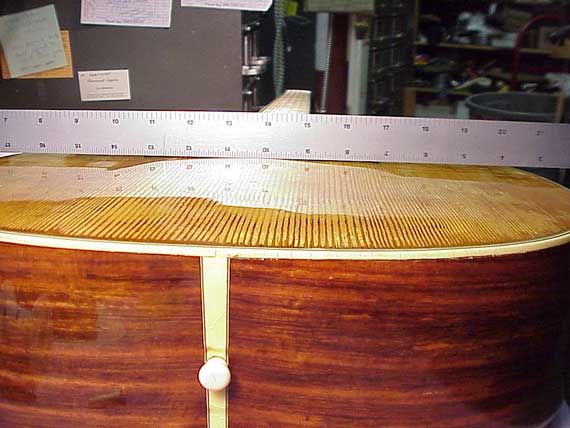Hi all, this poor thing just came in for repair. The owner acquired it in a trade, in 1968. By the mid-'70's it became unplayable, because of top bellying & high action. It went under the bed, with the string tension still on...for forty years.
It has the 'special' plastic bridge. The top is severely distorted/bellied, the worst I've seen to date. The most serious issue is a cross grain crack(cracked right through), running diagonally from the saddle bolt hole, paralleling the x-brace(but not, I think adjacent to the brace). I'll have to remove the (loose, cupped, plywood) bridge plate to be sure. One photo shows the outside of the top, with the crack indicated by arrows, and the x-brace by a tape strip. The inside photo shows the location of the outside crack, also with a tape strip. I think the crack follows the grain runout, through the top.
Should I attempt to reduce the severe bellying? And if so, how to accomplish this through the soundhole? The tone bars have taken on the curve of the belly.
Regarding the crack, my plan is to make a new, somewhat oversize bridgeplate, with the grain at 45 degrees(and perpendicular to the crack). The crack is close to, but not, I think, adjacent to the x-brace.
Will this be adequate? Suggestions?
Views: 449
- Attachments:
Replies to This Discussion
-
Your oversize bridge plate is likely to pull down the belly so significantly that I'm pretty sure you'll be pleased. Make it a good 1/8" thick with grain oriented as you suggest and clamp it solidly with a big flat plate over the top. Dry clamp first to make sure braces don't interfere with the flattening. With any luck they'll go along for the ride.
New bridge plate made this:
Into this:

-
Dave, I've done a few of these plastic bridge replacements and I've been amazed at how well they come back.
I came up with a fix that might be of use to you.
I heat up a piece of aluminum and squeeze a layer of firm silicone rubber against all the holes from underneath. The heat helps flatten things, seals the holes so glue doesn't pore through, and keeps the hide glue liquid longer.
I flood all the holes and loose fibers with hot hide, mop up the excess, and mash the top against the aluminum with a caul on the outside like Frank suggested.
After letting it dry thoroughly, (I put a fan on it for a couple of days) it's much flatter and more importantly the wood fibers of the holes are hard and stiff. Now they can be reamed cleanly and all the holes fit with tight fitting plugs.
- Attachments:
-
Nice Dave, very, very nicely done!
-
Hi Frank & Dave, thanks for you replies, they're very helpful!
It's always a bit distressing to me, when a customer shows me a guitar like this, which is obviously pulling itself apart(and has been for a while), and I must patiently explain 'take the tension off the strings immediately'!
© 2025 Created by Frank Ford.
Powered by
![]()
